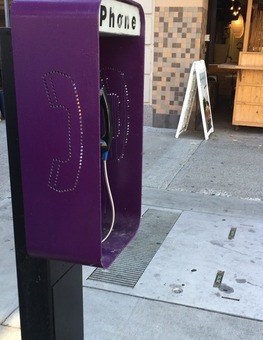4 min read | 916 words | 501 views | 0 comments
Adopt A Highway began as a local effort in Texas in the 1980s. Today, the program has spread all over the United States. It's hard to drive almost anywhere these days without seeing the iconic "Adopt A Highway" signs on the edge of the road. That's all great, and the idea could prove to have other useful applications as well.
Today, most payphones are owned by payphone providers, not telephone companies. Most telephone companies got out of the payphone business in the late 1990s or early 2000s. Today, PTS (Pacific Telemanagement Services) is the largest payphone provider in the U.S. If you've used a payphone recently, chances are good that it's a PTS phone. They have phones on both coasts and everywhere inbetween. Since they're not owned by the telephone company, they obviously don't work as seamlessly as a conventional payphone would have (Bell System payphones were all on dedicated coin lines, meaning if you somehow managed to tap into the line, it was futile, since the payphone wasn't responsible for billing and functionality, electromechanical equipment at the central office was — the payphone was essentially a "dumb" interface. Today, the payphones themselves have integrated circuitboards inside that are responsible for handling the functionality of payphones since payphones are usually on regular loop-start lines, not coin lines.)
Payphone vandalism is no longer as common as it once was. The locks that guard payphone coin vaults are some of the most secure in existence. They're incredibly resilient and resistant to drilling and most other attacks. The payphones that remain across the U.S. are usually taken pretty good care of. If you see a payphone pedestal, the phone inside is probably working. Drug dealers have long since abandoned payphones for disposable mobile phones, so the idea that payphones attract crime is now archaic. Most payphones today block incoming calls anyways.
That being said, a payphone is like a person. It's happier when it's well-fed; in this case, with lots of change. A payphone doesn't like running empty (and neither does PTS). Fortunately, if you're creative, there are several ways to support the payphone industry without asking for all of your change in quarters at the checkout line. (Remember those days?)
On a recent visit to Berkeley, I made a quick phone trip to check out the payphones. I saw 4 at UC-Berkeley, 6 inside the Downtown Berkeley BART Station, and 2 in downtown Berkeley. The one pictured below is the payphone right outside the downtown Berkeley BART station.
 Someone took it upon himself to cheer up this payphone by covering up its usual coat of blue with some perky purple.
Someone took it upon himself to cheer up this payphone by covering up its usual coat of blue with some perky purple.Certainly, you can help keep payphones profitable and around by using them to make coin calls. If you don't have any coins on you, though, that doesn't mean you can't use a payphone — toll-free calls are free from payphones too!
How does this help support payphones? Well, to understand that, we have to go back to 1999, when the FCC mandated that whenever a toll-free number receives a call successfully made from a payphone, it must pay the payphone provider $0.24. In 2004, the charge was increased to $0.49. Why the fee?
Most payphones charge fairly reasonable rates for calls. In the Bay Area, a local call is $0.50 for 15 minutes, a local toll call is $0.50 for 3 minutes, a long-distance call is $1.00 for 4 minutes, and an international call is $1.00 for 2 minutes. But for some people, particularly those who make long distance calls frequently from payphones, $1 for 4 minutes may be too expensive. To meet the need, many alternative long-distance providers have toll-free numbers that customers can call, punch in their PIN#, and then make an outgoing call on. "10-10-NXX" dial-around codes also exist for long distance companies, but toll-free numbers are more common.
Well, if you had direct-dialed your long distance call, the payphone provider makes money. When you dial a toll-free provider from a payphone and use their long-distance service, the payphone doesn't get fed. The FCC thought this wasn't fair, and decided that ANY calls to toll-free numbers will result in compensation to the payphone provider. Notice the amount of this compensation is about the same as the cost for 1 local call.
Because of this, some toll-free numbers simply block calls from payphones. Calling 1-800-FREE-411 from a payphone will result in a snooty "Sorry, your call cannot be completed from a payphone as dialed" error message. Calling Microsoft Tech Support results in a reorder tone. That being said, most toll-free numbers do not block calls from payphones. Consequently, there exists the possibility for abuse. In one case, a shady payphone provider scammed $1.2 million out of various toll-free numbers by fraudulently programming payphones to dial toll-free numbers at random when not in use. Usually, when something like this happens, the provider is shut down and the men behind the scheme go to jail.
As long as you're not a payphone provider and using your own phones to dial toll-free calls, however, there's nothing fradulent about using payphones for all your toll-free calls. They cost nothing to you, of course, and you can help support payphones by doing so. The Payphone Project said it best: Gaming the system via auto-dialing payphones is obviously wrong and anyone doing what Nicolaos Kantartzis and the others did will probably get caught eventually. On the other hand, if you want to help support your local payphone provider without incurring any cost to yourself, then consider using a payphone the next time you need to call a toll-free number.
Log in to leave a comment!